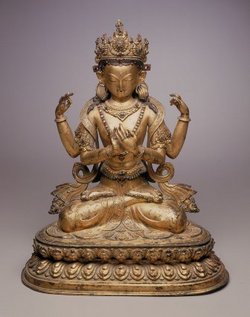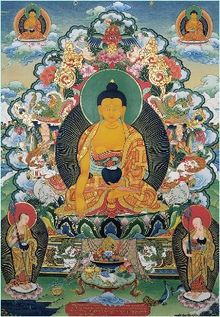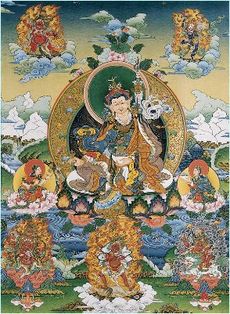|
|
| (158 intermediate revisions by 4 users not shown) |
| Line 1: |
Line 1: |
| == ''A Glossary of Buddhist People, Places, and Things...'' == | | <div style="top:+0.2em;font-size: 110%"> |
| ''- '''The Terms by which They're Defined''' -'' | | <center>'''~~ <span class=TibUni20>[[རང་བྱུང་ཡེ་ཤེས་ཕིབ་རྒྱ་དཀོན་མཆོག་ཕོ་བྲང་ཆོས་ཀྱི་ཕྲིན་ལས།]]</span> ~~'''</center></div> |
| | ---- |
| | <center>'''''~~ A Glossary of Buddhist People, Places, and Things...~~'''''</center> |
| | ---- |
| | <table align="center"> |
| | <tr> |
| | <td>[[Image:Buddha_6.jpg|thumb|220px|<center>'''[[Buddhas of the Three Times]]''']]</center></td> |
| | <td>[[Image:PrajnaParamita.jpg|thumb|250px|<center>'''[[Prajnaparamita]]''' - ([[sher phyin ma]]) - </center><center><BR>{{:sher phyin ma}}</center><center>Guardian Deity of [[The Perfection of Wisdom]] - [[Mother of All Buddhas]]<br>(picture source unknown)</center>]]</td> |
| | <td>[[Image:Padmadsat_6.jpg|thumb|230px|<center>'''[[Padmasambhava]] Refuge''']]</center></td> |
| | </tr> |
| | </table> |
| | ---- |
| | <center>''''' ~~ The Terms by which These Are Defined ~~ '''''</center> |
| | ---- |
| | --'''Alphabetical Listing:'''<br> |
| | <center>'''[[A]]''' - '''[[B]]''' - '''[[C]]''' - '''[[D]]''' - '''[[E]]''' - '''[[F]]''' - '''[[G]]''' - '''[[H]]''' - '''[[I]]''' - '''[[J]]''' - '''[[K]]''' - '''[[L]]''' - '''[[M]]''' - '''[[N]]''' - '''[[O]]''' - '''[[P]]''' - '''[[Q]]''' - '''[[R]]''' - '''[[S]]''' - '''[[T]]''' - '''[[U]]''' - '''[[V]]''' - '''[[W]]''' - '''[[X]]''' - '''[[Y]]''' - '''[[Z]]'''</center> |
| | ---- |
| | ''''' "It is all right not to know the Tibetan language. As long as you can read, you can absorb the [[Dharma]] terminology, the Buddhist key words. Many learned people have told me that the majority of Buddhist scriptures exist in the Tibetan language. Second is Chinese; after that there is Japanese, Pali, and so forth. Nevertheless, Tibetan is foremost in quantity. Someone who wants to do detailed studies, can study to their heart's delight in the Tibetan medium, without running out of texts".''''' |
|
| |
|
| -'''[[B]]''' - '''[[C]]''' - '''[[D]]''' - '''[[E]]''' - '''[[F]]''' - '''[[G]]''' - '''[[H]]''' - '''[[I]]''' - '''[[J]]''' - '''[[K]]''' - '''[[L]]''' - '''[[M]]''' - '''[[N]]''' - '''[[O]]''' - '''[[P]]''' - '''[[Q]]''' - '''[[R]]''' - '''[[S]]''' - '''[[T]]''' - '''[[U]]''' - '''[[V]]''' - '''[[W]]''' - '''[[X]]''' - '''[[Y]]''' - '''[[Z]]''' -
| | Quoted from an interview with '''''[[Chokyi Nyima Rinpoche]]''''' '''-''' <span class=TibUni16>[[ཆོས་ཀྱི་ཉི་མ་རིན་པོ་ཆེ།]]</span> |
| ---- | | ---- |
| '''A'''<br> | | '''Note:''' To review the images above, their source, more details and availability, please see '''http://www.thangka.ru/gallery_e.html'''. ''Thank you Nick!''<br> |
| <br>
| |
| Abandonment and realization ([[spangs rtogs]]). - A synonym for 'buddhahood' or 'enlightenment.' ([[bla ma'i thugs rgyud kyi spangs rtogs kyi yon tan]]) -- the qualities of freedom and realization of the teacher's wisdom mind [RY]<br><br>
| |
| Abhidana of the Samvara Tantra - a tantric text. [RY]<br>
| |
| <br>
| |
| Abbot, the Master, and the Dharma King: are [[Shantarakshita]], [[Padmasambhava]], and [[Trisong Deutsen]]<br>
| |
| <br>
| |
| [[Abhidharma]] -([[chos mngon pa]])- 1) systematic teachings which analyze elements of experience and investigate the nature of existence, thus dispelling wrong views and establishing analytic insight. 2) One of the three parts of the [[Tripitaka]], the Words of the [[Buddha]], the essence of which is prajna, or [[discriminating knowledge]] ([[kun rtogs ye shes]]). 3) Branch of Buddhist literature and practice concerned with the analysis of phenomena into their elementary constituents ([[dharmas]]). 4) Systematic teachings on metaphysics focusing on the training and developing of discriminating knowledge by analyzing elements of experience and investigating the nature of existing things. The chief commentaries on Abhidharma are the [[Abhidharma Kosha]] by [[Dignaga]] from the [[Hinayana]] perspective, and the [[Abhidharma Samucchaya]] by [[Asanga]] from the [[Mahayana]] point of view. Dignaga was a disciple of [[Vasubandhu]]. Vasubandhu was later converted to Mahayana by Asanga. [RY]<br>
| |
| <br>
| |
| [[Abhidharma Kosha]] -([[mngon pa mdzod]])-. An authoritative scripture on Buddhist metaphysics according to Hinayana, composed by the Indian pandita [[Dignaga]]. [RY]<br>
| |
| <br>
| |
| [[Abhidharma Pitaka]] -([[mngon pa'i sde snod]])-. One of The Three Pitakas -([[sde snod gsum]])-, containing the foundation of Buddhist psychology and logic. It describes the universe, the various types of beings, the steps on the path to enlightenment, refutes wrong views and so forth. [RY]<br>
| |
| <br>
| |
| [[Abhidharma Samuccaya]] -([[mngon pa kun btus]])-. An authoritative scripture on Buddhist metaphysics according to Mahayana, composed by the Indian [[pandita]] [[Asanga]]. [RY]<br>
| |
| <br>
| |
| [[Abhisamaya Lamkara]] -([[mngon rtogs rgyan]])- The 'Ornament of Realization' authored by [[Maitreya]] and written down by [[Asanga]]. It explains the paths and [[bhumis]] of the [[bodhisattva vehicle]]. [RY]<br>
| |
| <br>
| |
| [[Abhisheka]] -([[dbang bskur]])-. See [[empowerment]]. [RY]<br>
| |
| <br>
| |
| absolute ([[yongs grub]]) [LW1] [RY]<br>
| |
| <br>
| |
| [[absolute]] ([[yongs grub]]); unchanging ([['gyur med yongs grub]]), expl.; unmistaken ([[phyin ci ma log pa'i yongs grub]]), expl. [LWx] [RY]<br>
| |
| [ [[RWB]] ]
| |
| <br>
| |
| [[absolute bodhicitta]] -([[don dam byang chub gyi sems]])- corresponds to the realization of emptiness. The [[relative bodhicitta]] -([[kun rdzob byang chub kyi sems]])- is the wish to attain enlightenment for the sake of others and the putting of this wish into action.
| |
| [MR-ShabkarNotes]<br>
| |
| <br>
| |
| [[Abu]] -(a bu)-. Another name for Paltrul Rinpoche, Jigme Choskyi Wangchuk (1808-87), also known as Dzogchen Palge Tulku. [RY]<br>
| |
| <br>
| |
| [[Acarya]] -([[slob dpon]])- master. [RY]<br>
| |
| <br>
| |
| [[Acceptance]] -([[bzod pa]])- One of the 'four aspects of ascertainment' attained on the path of joining. [RY]<br>
| |
| <br>
| |
| Acceptance of the profound Dharma -([[zab mo'i chos la bzod pa]])- Acceptance of emptiness; that [[dharmas]] are unproduced. [RY]<br>
| |
| <br>
| |
| Acceptance that dharmas are unproduced - ([[mi skye ba'i chos la bzod pa]]) Skt. anutpattika-dharma-ksanti - An important realization gained on entry to the eighth Bodhisattva Stage. [RY]<br>
| |
| <br>
| |
| [[Accomplishment]] -([[dngos grub]], Skt. [[siddhi]])- 1) See '[[supreme and common siddhis]] 2)-([[sgrub pa]])- See 'four aspects of approach and accomplishment.'. 3) The result of the practice. [RY]<br>
| |
| <br>
| |
| Accomplishment of Means and Knowledge ([[thabs shes grub pa]]) [LW1] [RY] <br>
| |
| <br>
| |
| Accomplishment of Nonduality ([[gnyis med grub pa]]) [LW1] [RY]<br>
| |
| <br>
| |
| Accomplishment of Secrets ([[gsang ba grub pa]]) [LW1] [RY]<br>
| |
| <br>
| |
| Accomplishment of Thatness to Clearly Encompass Reality ([[dngos po gsal ba'i rjes su 'gro ba'i de kho na nyid grub pa]]) [LW1] [RY]<br>
| |
| <br>
| |
| Accomplishment of the Great Secret Thatness ([[gsang ba chen po de nyid grub pa]]) [LW1] [RY]<br>
| |
| <br>
| |
| Accomplishment of the Innate ([[lhan skyes grub pa]]) [LW1] [RY]<br>
| |
| <br> | | <br> |
| Accomplishment of Wisdom ([[ye shes grub pa]]) [LW1] [RY]<br>
| | (Review other [[Special:Categories|Categories]]) |
| <br> | | <br> |
| ACCOMPLISHMENT. 1) ([[dngos grub]]), Skt. [[siddhi]]. The attainment resulting from Dharma practice usually referring to the 'supreme accomplishment' of complete enlightenment. It can also mean the 'common accomplishments,' eight mundane accomplishments such as clairvoyance, clairaudiance, flying in the sky, becoming invisible, everlasting youth, or powers of transmutation. The most eminent attainments on the path are, however, renunciation, compassion, unshakable faith and realization of the correct view. See also 'supreme and common accomplishments.' 2) ([[sgrub pa]]). See also 'approach and accomplishment.'[AL] [RY]<br>
| |
| <br> | | <br> |
| [[Accumulation of merit]] ([[bsod nams kyi tshogs]]) - Virtuous actions or meditation practice carried out with conceptual mind; for instance, the concepts of oneself, the deed and the purpose. [Bardo Guide 91] [RY]<br>
| |
| <br>
| |
| [[Accumulation of wisdom]] ([[ye shes kyi tshogs]]). Virtuous actions embraced by the discriminating knowledge ([[shes rab]]) of insight into emptiness, naked mind free from conceptual thinking.. [RY]<br>
| |
| <br>
| |
| [[Accumulation(s)]] ([[tshogs]]). The provisions for journeying along the path of enlightenment. See the '[[Accumulations, the two]].' [RY]<br>
| |
| <br>
| |
| [[Accumulations, the two]] ([[tshogs gnyis]]). The accumulations of merits and of Wisdom-knowledge that one must gather by practicing the Perfections so as to achieve Enlightenment. [RY]<br>
| |
| <br>
| |
| [[Acharya Lilavajra]]. One of the Indian mahasiddhas. [RY]<br>
| |
| <br>
| |
| [[Acharya Nagarjuna]] ([[slob dpon klu sgrub]]). A great Indian master of philosophy. He was named "Naga Master" because he taught the beings in the naga world and returned with the extensive version of Prajnaparamita left in their safe keeping. [RY]<br>
| |
| <br>
| |
| Acharya Padma. [Daki] [RY] <br>
| |
| <br>
| |
| Acharya Padmavajra. [Daki] [RY]<br>
| |
| <br>
| |
| Acharya Shantipa ([[slob dpon shan ti pa]]) - An Indian master in the Mahamudra lineage. [RY]<br>
| |
| <br>
| |
| Acharya Tubten Chöphel [LW1] [RY]<br>
| |
| <br>
| |
| Action dagger ([[las phur]]) - The kilaya for fulfilling the activities in the practice of Vajra Kilaya. [RY]<br>
| |
| <br>
| |
| Action Family (karma-kula, [[las kyi rigs]] ([[tshogs]])) - The Family of Amoghasiddhi. [RY]<br>
| |
| <br>
| |
| Action resembling its cause ([[byed pa rgyu mthun]]) - The ripening of karma showing itself as the tendency to repeat the same kind of action. [RY]<br>
| |
| <br>
| |
| action seal [LW1] [RY]
| |
| Action Tantra ([[bya ba'i rgyud]]) - Kriya [LW1] [RY]<br>
| |
| <br>
| |
| Action without intermediate ([[mtshams med pa'i las]]) - Five actions with the most severe karmic effect: killing one's mother, one's father, or an arhant; causing schism in the sangha of monks; and drawing blood from a tathagata with evil intent. These actions can also be called 'immediates' because their karmic effect will ripen immediately after death without leaving time to go through a bardo state. [ZL] [RY]<br>
| |
| <br>
| |
| Action, act, activity, rite (karman; [[las]], [[phrin las]], [['phrin las]]). For the activity of a Buddha, or for Tantric rites, Tib. often used the honorific (')phrin las, which I have sometimes translated as 'divine action' or 'divine activity'. The 'four activities' or 'four rites' are Pacifying or Calming, Increasing, Subjugating or Subduing, and Fierceness. See also karma. [RY]<br>
| |
| <br>
| |
| Activities ([[las]], [[phrin las]]). Usually referring to the four activities of pacifying, increasing, magnetizing and subjugating. [ZL] [RY]<br>
| |
| <br>
| |
| Activities. See 'four activities.' [RY]<br>
| |
| <br>
| |
| Activity dakinis. [Daki] [RY]<br>
| |
| <br>
| |
| Activity Garland Tantra ([[kar ma ma le 'phrin las kyi rgyud]]) - A Mahayoga scripture listed here as one of the Six Secret Sections. Sometimes also mentioned as one of the Eighteen Mahayoga Tantras as the tantra of enlightened activity. Texts with this name are found both in Vol. TSA and SHA of the [[Nyingma Gyübum]]. [ZL] [RY]<br>
| |
| <br>
| |
| Activity practices ([[las tshogs]]). They refer chiefly to the four activities of pacifying, increasing, magnetizing and subjugating. [RY]<br>
| |
| <br>
| |
| Adamantine, Concentration called (Vajropamo nama samadhih, [[rdo rje lta bu zhes bya ba'i ting nge 'dzin]]). The concentration in which Liberation or the Enlightenment of a Buddha is attained. Called 'destroyer of hostile forces' (para-sainya-pramardin) since it eliminates the last obstructions. [RY]<br>
| |
| <br>
| |
| Adhi Rinpoche (a dhih rin po che [LW1] [RY]<br>
| |
| <br>
| |
| Adi Buddha Samantabhadra ([[mdod ma'i sangs rgyas kun tu bzang po]]). 1) The primordially enlightened buddha. 2) the all-pervasive primordial Buddha from whom radiates the five Dhyanibuddhas; the representation of dynamic energy that brings from into existence. [RY]<br>
| |
| <br>
| |
| Adityabandhu ([[nyi ma'i gnyen]]: kinsman or friend of the sun) An epithet of Sakyamuni Buddha.<br>
| |
| <br>
| |
| [[Aeon]] ([[bskal pa]], Skt. [[Kalpa]]) - 1) World-age, period, cosmic cycle. 2) World-age, cosmic cycle. 3) Cosmic period. There are small aeons, intermediate aeons and big aeons. An intermediate aeon consists of two small aeons, and a big aeon consists of 80 intermediate aeons. 4) Aeon of Strife ([[rtsod dus]]) [LW1] [RY]<br>
| |
| <br>
| |
| Afflicted mind consciousness ([[nyon yid kyi rnam shes]]) - A term used in the abhidharma teachings. It is one of the eight consciousnesses which harbors the thought "I am" and is the basis for all negative emotions. One of the eight collections. [RY]<br>
| |
| <br>
| |
| [[Affliction]] ([[kun nyon]]) state of, [LW1] [RY]<br>
| |
| <br>
| |
| Agang Monastery ([[a 'gang]]), at Machuka ([[rma chu kha]]). There is a miraculously-formed image of Hayagriva known as rma khar rta mgrin rang byung. [MR-ShabkarNotes]<br>
| |
| <br>
| |
| Age of Destruction ([['jig dus]]). When seven suns blaze and the whole world is consumed in a firestorm [RY]<br>
| |
| <br>
| |
| age of residues ([[snyigs dus]]), which is characterized by a degeneration in 1) the life span ([[tshe]]), 2) the general karma ([[las]]), 3) the view ([[lta ba]]), and 4) the faculties of beings ([[sems can]]), as well as by 5) an increase of the obscuring emotions ([[nyon mongs]]). [MR-ShabkarNotes]<br>
| |
| <br>
| |
| Age of Strife (kali-yuga, [[rtsod dus]]). 1) The present world-age. 2) The present world-age dominated by decline and degeneration. [ZL] [RY]<br>
| |
| <br>
| |
| [[Aggregate]](s) ([[phung po]]). See 'five aggregates.' [RY]<br>
| |
| <br>
| |
| [[Agitation]] ([[rgod pa]]). The state of mind disturbed by thoughts and emotions. [RY]<br>
| |
| <br>
| |
| Agitation and fading (layauddhatya, [[bying rgod]]). faults of meditation. [RY]<br>
| |
| <br>
| |
| Agnean - Another name for the Central Asian Dharma language known as Tokharian A [RY]<br>
| |
| <br>
| |
| Agni (agni, anala; [[me lha]]). The Vedic god of fire, guardian of the south-eastern direction. [RY]<br>
| |
| <br>
| |
| Aids to Bodhi, or to Enlightenment (bodhi-paksika-dharma, [[byang chub phyogs chos]]). A series of seven groups of qualities - thirty-seven in all - to be practiced at successive stages of the Path. [RY]<br>
| |
| <br>
| |
| [[Aishvara]] [LW1] [RY]<br>
| |
| <br>
| |
| [[Ajanta]] - Site of major Buddhist cave temples; the later Mahayana temples are renowned for their art [RY]<br>
| |
| <br>
| |
| [[Ajatashatru]] - 1) Son of bimbisara and ruler of Magadha at the time of the Parinirvana; he provided for the needs of the First Council 2) Son of King Bimbishara of Magadha. Abetted by the rebellious Devadatta, he we usurped the throne, imprisoned his parents, and starved them to death. After he had conquered and annexed neighboring states, laying the foundation for the unification of India, he became afflicted with a skin disease. Remorseful, he went to the Buddha to repent his sin and take refuge in him. After the Buddha's parinirvana, King Ajatashatru sponsored the 500 arhats to collect the Buddha's teachings. Indian Buddhism is greatly indebted to the converted King Ajatashatru for his prevalence and prosperity. [RY]<br>
| |
| <br>
| |
|
| |
|
| |
|
| |
|
|
| | [[Category: Glossary]][[Category: Dictionary]][[Category: Key Terms]][[Category: Teachings]] |
| <br><br><br>
| |
| -A Work in Progress---[[User:Richard|Richard]] 03:43, 22 January 2006 (EST) [RWB]
| |
|
| |
|
| [[Category: Glossary]][[Category: Dictionary]] | | --(A Work in Progress) --[[User:Richard|Richard]] 04:32, 16 April 2009 (UTC)-- |


